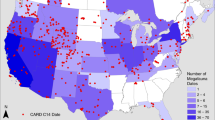Abstract
Non-analogue methods for Quaternary palaeoclimatic reconstruction, such as the coleopteran Mutual Climate Range method and the Mutual Ostracod Temperature Range (MOTR) method, use large geographical databases combined with modern climate datasets to establish the modern climate/temperature ranges of species, which can then be applied to the interpretation of fossil assemblages. Such approaches have been criticized for their lack of attention to variation in the distributions of species within their climate ranges. The MOTR method, for example, assumes that a species has an equal probability of occurring anywhere within its temperature range (e.g. mean July air temperature range), but tests using calculated averages of all records (as opposed to just the two end-points that define the range) show this to be false. The MOTR method remains valid, nevertheless, as long as it is only used to estimate the temperature ranges within which a fossil assemblage could have existed. Analyses of the distributions of 65 species within European climate space show that most are not normal, but often skewed and sometimes polymodal. The factors influencing such variations are discussed and consideration is given to ways of taking them into account in palaeotemperature estimations based on ostracod assemblages. A revised calibration table is presented, showing the modern air temperature ranges of 65 species, for use with the MOTR method.
Similar content being viewed by others
References
Atkinson, T.C., Briffa, K.R., Coope, G.R., Joachim, M.J. &Perzy, D.W. (1986): Climatic calibration of Coleopteran data. — In:Berglund, B.E. (Ed.), Handbook of Holocene palaeoecology and palaeohydrology: 851–858; New York (Wiley).
Bray, P.J., Blockley, S.P.E., Coope, G.R., Dadswell, L.F., Elias, S.A., Lowe, J.J. &Pollard, A.M. (2006): Refining mutual climatic range (MCR) quantitative estimates of palaeotemperature using ubiquity analysis. — Quaternary Science Reviews,25: 1865–1876.
Coope, G.R. (2002): Changes in the thermal climate in northwestern Europe during Marine Isotope Stage 3, estimated from fossil insect assemblages. — Quaternary Research,57: 401–408.
Coope, G.R., Lemdahl, G., Lowe, J.J. &Walkling, A. (1998): Temperature gradients in northern Europe during the last glacial — Holocene transition (14–9l4C kyr BP) interpreted from coleopteran assemblages. — Journal of Quaternary Science,13: 419–433.
Elias, S.A. (1997): The Mutual Climate Range method of palaeoclimate reconstruction based on insect fossils: new applications and interhemispheric comparisons. — Quaternary Science Reviews,16: 1217–1225.
Hijmans, R.J., Cameron, S.E., Parra, J.L., Jones, P.G. &Jarvis, A. (2005): Very high resolution interpolated climate surfaces for global land areas. — International Journal of Climatology,25: 1965–1978.
Hijmans, R.J.,Guarino, L.,Cruz, M. &Rojas, E. (2001): Computer tools for spatial analysis of plant genetic resources data: 1. DIVA-GIS. — Plant Genetic Resources Newsletter, No.127: 15–19.
Horne, D.J. (2007): A Mutual Temperature Range method for Quaternary palaeoclimatic analysis using European nonmarine Ostracoda. — Quaternary Science Reviews,26: 1398–1415.
Horne, D.J.,Baltanás, A. &Paris, G. (1998): Geographical distribution of reproductive modes in living non-marine ostracods. — In:Martens, K. (Ed.), Sex and parthenogenesis: evolutionary ecology of reproductive modes in non-marine ostracods: 77–99; Backhuys, Leiden, the Netherlands.
Huppert, A. &Solow, A.R. (2004): A method for reconstructing climate from fossil beetle asemblages. — Proceedings of the Royal Society, London,B 271: 1125–1128.
Juggins, S. (2005): C2 Version 1.4: Software for ecological and palae-oecological data analysis and visualization; Newcastle upon Tyne (University of Newcastle).
Lyons, S.K. (2003): A quantitative assessment of the range shifts of Pleistocene mammals. — Journal of Mammalogy,84: 385–402.
Moine, O., Rousseau, D.-D., Jolly, D. &Vianey-Liaud, M. (2002): Paleoclimatic reconstruction using Mutual Climatic Range on terrestrial molluscs. — Quaternary Research,57: 162–172.
Pross, J., Klotz, S. &Mosbrugger, V. (2000): Reconstructing palaeotemperatures for the Early and Middle Pleistocene using the mutual climatic range method based on plant fossils. — Quaternary Science Reviews,19: 1785–1799.
Sinka, K.J. &Atkinson, T.C. (1999): A mutual climatic range method for reconstructing palaeoclimate from plant remains. — Journal of the Geological Society, London,156: 381–396.
SPSS Inc. (2004): SPSS ®; 13.0 Guía Breve. — 1–241; Chicago (SPSS Inc.).
ter Braak C.J.F. &Looman, C.W.N. (1995): Regression. — In:Jongman, R.H.G.,ter Braak, C.J.F. &van Tongeren, O.F.R. (Eds): Data analysis in community and landscape ecology: 29–77; Cambridge University Press.
Wetterich, S., Schirrmeister, L., Meyer, H., Viehberg, F.A. &Mackensen, A. (2007): Arctic freshwater ostracods from modern periglacial environments in the Lena River Delta (Siberian Arctic, Russia): geochemical applications for palaeoenvironmental reconstructions. — Journal of Paleolimnology,39: 427–449.
Author information
Authors and Affiliations
Corresponding author
Rights and permissions
About this article
Cite this article
Horne, D.J., Mezquita, F. Palaeoclimatic applications of large databases: developing and testing methods of palaeotemperature reconstruction using nonmarine ostracods. Senckenbergiana lethaea 88, 93–112 (2008). https://doi.org/10.1007/BF03043981
Received:
Accepted:
Issue Date:
DOI: https://doi.org/10.1007/BF03043981




